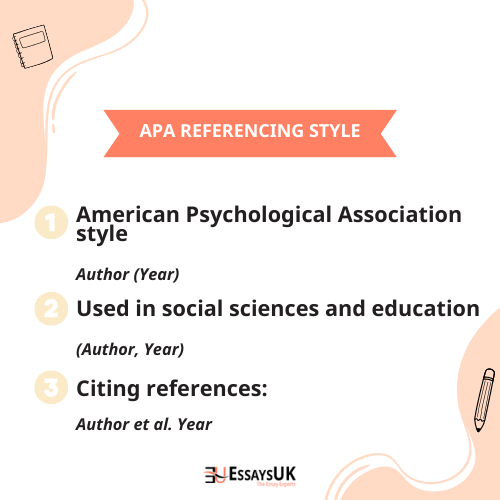
The APA style is recommended by the American Psychology Association. It is one of the most common referencing styles used by authors and scholars worldwide. APA referencing style allows researchers and writers to present clear, concise and focused scholarly communication to improve the clarity and focus of the document.
APA style is a commonly used referencing style for academic writing in social sciences. The changes in the 7th edition of the APA style guide include updated guidelines for citing sources in research papers, including how sources should be cited in-text and in reference lists. This section comprehensively discusses how to cite sources in APA 7th edition.
Intext-citations are inserted within the text of your research paper to refer to the reference entry at the end of the paper. It is used to source your information. Any text taken from another source must be cited in your research paper. In APA, the author-date format is used for intext-citations, meaning that the author’s name and the year of the publication will appear in the text
For example, (Adam, 2022).
This formatting is used when referring to the entire document, book or other sources. When citing specific page numbers from a source, you have to add the number at the end of the parenthetical citation. One page is denoted by “p.” while multiple pages are represented by “pp.” with a dash in the centre to separate pages.
Examples:
Take care of the following capitalisation rules while writing intext-citations.
There are two types of intext-citations
In Parenthetical citations, sources are cited inside a parenthesis.
Example:
“APA referencing style is popular among researchers” (Adam, 2022)
In a narrative citation, the author's name is a part of the sentence with the year in parentheses.
Example:
Adam (2022) believes that students often face difficulty using APA-style formatting.
With EssaysUK you get:
In the case of multiple authors, make use of the ampersand (&).
For example
(Adam & Syed, 2022). For more than two authors, use et al. with the name of the primary author. E.g. (Adam et al., 2022). If the author is an organisation, then it would be represented like this (EssaysUK, 2022).
The APA format recommends using a reference list at the end of the document instead of a bibliography. The reference list is a comprehensive list of all the sources cited in the paper. The guide for setting up the reference page is given later in this article. The basic format for a reference list in APA 7th edition is as follows:
What is the difference between a reference list and a bibliography?
A reference list and a bibliography are lists of sources that have been used in a research paper or other written work, but they have different purposes and include different types of sources.
A reference list contains sources that have been directly cited or quoted in the text of a paper. It is typically included at the end of the paper and includes only the sources referred to within the text. The author's last name should alphabetically follow the reference list.
A bibliography is a list of sources consulted during the research process but may have yet to be directly cited or quoted in the text. A bibliography may include sources such as books, articles, and websites that provide background information but were not directly cited in the paper. A bibliography should also be in alphabetical order by the author's last name.
The headings and subheadings in APA format are used to distinguish the different elements or chapters of the paper. The structure of an APA format paper includes the following elements:
These are the basic components of an APA format paper. However, the structure may vary depending on the specific assignment or the type of research being conducted.
The formatting guidelines for the APA referencing are given below.
1. Adam, S. (2022). A complete guide to APA style referencing (4th ed.)
Intext Citation: (Adam, 2022) or Adam (2022)
2. Musa, L. M., & Post, D. L. (2011). What is APA style formatting? Journal of English Literature, 90(6), 300-356
Intext Citation: (Musa & Post, 2022, pp.300-356)
Of course, you can cite a source that has no author associated with it. However, always look for the organisation, company, charity, business or website the source belongs to, and use their name as the author in-text citations and in the references list. In some cases, you may not be able to identify the author as the document is completely anonymous. A wiki article is one such example. In that case, you are allowed to use the title as the author of the paper. Shorten the title if necessary, especially when adding the source in the in-text citations.
If you are citing a quote, phrase, or a large piece of text, you must specify the exact location of the passage. When you need to cite a source that has no page numbers, for example, a website, provide information that helps the reader to identify the exact location of the passage. Use headings or their shortened versions, subheadings, paragraph numbers and line numbers of the combination of two markers to point to the exact location the passage belongs to.
For example: (Smith, 2021, para. 5)
In academic referencing, et al. means “and others”. You can use et al. to shorten in-ext situations having two or more authors. The concept is easy: Write the surname of the first author’s name, followed by et al. a comma, and the year of publication. For example (Michael et al., 2022).